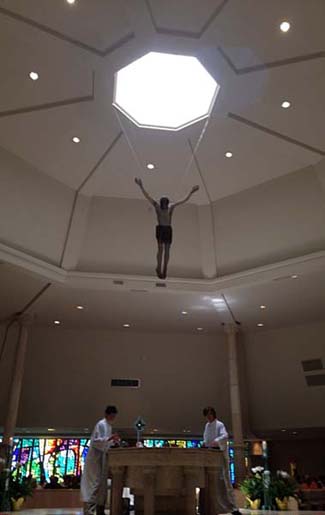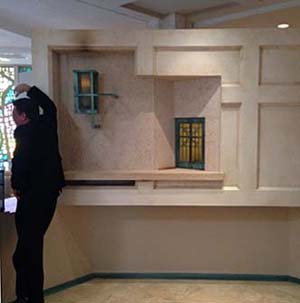Architecture speaks, and, like a homily or proclamation of scripture, it can change us profoundly. It preaches and teaches every time we enter a church building. When it speaks truth it reminds us that God is central, and that we are broken and in need of a savior who offers us a place of eternal unity with God. It reveals to us that we are on hallowed ground and should act differently than we did before we entered. It instinctively draws us to our knees, to worship, and to focus on him. It tells us that God, in the greatest act of love ever known to man, has given his life for us by providing his son as a sacrifice for our sins.
 Whenever we enter into a properly designed and ornamented church, we imagine the great mysteries of salvation presented to the eye as they so often are to the ear, and this kind of preaching could be called architectural orthodoxy. A beautiful church either presents to us the full truth of the liturgy or it does not. It either reminds us that the sacred liturgy takes place in the Heavenly Jerusalem with the other members of the Mystical Body of Christ or it does not. It either fills us with desire to become like God and the saints, or it misses a great opportunity to move our wills to offer ourselves to God. Church architecture, then, is not simply about style, or fashion, or subjective taste but about our genuine encounter with God. Unlike an interior decorator picking pleasant colors for purely aesthetic purposes, church design involves the production of divinely inspired sacred art for the salvation of the world. For this reason, Paul VI said that the work of artists was very much like that of the priest: they use the matter of the world to render God present.
Whenever we enter into a properly designed and ornamented church, we imagine the great mysteries of salvation presented to the eye as they so often are to the ear, and this kind of preaching could be called architectural orthodoxy. A beautiful church either presents to us the full truth of the liturgy or it does not. It either reminds us that the sacred liturgy takes place in the Heavenly Jerusalem with the other members of the Mystical Body of Christ or it does not. It either fills us with desire to become like God and the saints, or it misses a great opportunity to move our wills to offer ourselves to God. Church architecture, then, is not simply about style, or fashion, or subjective taste but about our genuine encounter with God. Unlike an interior decorator picking pleasant colors for purely aesthetic purposes, church design involves the production of divinely inspired sacred art for the salvation of the world. For this reason, Paul VI said that the work of artists was very much like that of the priest: they use the matter of the world to render God present.
Then there are times when the religious message is mute—or worse. This happens when we enter a church that turns out to be more profane than sacred. The architects and their ecclesiastical clients were either asleep at the wheel, part of a nefarious plot to deliberately undermine the faith, or improperly trained in theology and the sacramentality of art. The architectural elements in these buildings can preach appealing half-truths or even lies: “You, not God, are the most important thing going on here, so enjoy yourself and applaud” or “The earthly community in fellowship is the true nature of liturgical action.” Several years ago I visited a parish that clearly illustrated this problem.
Orthodox. Faithful. Free.
Sign up to get Crisis articles delivered to your inbox daily
When I entered into this architectural charade, I was filled immediately with a sense of confusion. It was difficult to discern where to genuflect or how best to follow the flow of the Mass. It completely lacked a focal point, despite the Church’s clear assertion in the Rite of Dedication of a Church and Altar that the altar is a symbol of Christ. The presence of God was masked and hidden away. For many decades, liturgists raised concerns about the tabernacle being primarily located in a separate chapel for private devotion. Today, one has to ask what the motivation is behind an even greater travesty: making it hard to know where the Eucharist is reserved.
One of the more disturbing elements was on display above the altar, where a barely recognizable human form appeared to be parachuting down through a skylight into what might have been the sanctuary.
The anthropocentric Church-in-the-round design didn’t readily allow for a crucifix above or behind the altar, so someone came up with the idea of this directionless and indistinct wire-frame body (absent of any of the trauma of crucifixion or clear human expression). The priest and altar boys processed in with only an unusual stained-glass cross, without a corpus, that perfectly echoed the amorphous Christlessness of the place. While, naturally, the Church recognizes Christ’s sacrifice of his own body, it also venerates the cross itself, as the liturgy of Good Friday tells us: “Behold the wood of the Cross on which hung the salvation of the world.” While indeed Catholics rejoice in the Resurrection, they understand Christ’s offering of himself to the Father as an eternal act, a perfect and constant offering of love. For this reason, the Mass can be offered as the one sacrifice of Christ to the Father again and again. And for this reason, a cross, and not just a corpus, belongs in a Catholic church. Without it, the result is both visually bizarre and theologically deficient.
 I looked around and confirmed that there was no liturgical crucifix in what was supposed to be either the sanctuary or the nave. The only crucifix I could find in that room was in the form of a tiny, banal representation of one of the Stations of the Cross (about two or three inches high, at most). The stations were small and so devoid of clarity that if you mixed them up and removed the numerals, you would be hard-pressed to put them back together in order. This great opportunity to encounter the central acts of the Paschal Mystery was diminished, reduced, and—probably by intent—hidden. This is not the artwork of the New Evangelization, but rather ashamed non-evangelization, or worse. I later discovered that the parish did have an older traditional crucifix relegated to the narthex, I suppose to pacify the original parishioners who were still around when the new church was built and who probably actually believed in something.
I looked around and confirmed that there was no liturgical crucifix in what was supposed to be either the sanctuary or the nave. The only crucifix I could find in that room was in the form of a tiny, banal representation of one of the Stations of the Cross (about two or three inches high, at most). The stations were small and so devoid of clarity that if you mixed them up and removed the numerals, you would be hard-pressed to put them back together in order. This great opportunity to encounter the central acts of the Paschal Mystery was diminished, reduced, and—probably by intent—hidden. This is not the artwork of the New Evangelization, but rather ashamed non-evangelization, or worse. I later discovered that the parish did have an older traditional crucifix relegated to the narthex, I suppose to pacify the original parishioners who were still around when the new church was built and who probably actually believed in something.
All of this was troubling enough, but even more egregious was the treatment of the Tabernacle. It was as if the Real Presence of Jesus Christ were an embarrassing, superstitious afterthought that must be hidden or minimized to accommodate the focus of the parishioners on one another. Off to one side, outside of what might have been the sanctuary, it was constructed in such a way as to encourage all manner of dismissive lounging around without any concern for the Son of God present within (as illustrated in this deeply troubling photo).
In the end, the milquetoast heresy of this architecture can be summarized as follows:
- The heavenly realities and beautiful promises of eternal salvation are no longer accessible by sacramental revelation.
- We do not worship with the angels, the saints, and all of creation.
- Jesus didn’t really suffer and die for our sins; we’re not sure he was anything more than a good man.
- The Eucharist is merely a ceremonial memory of the good man. No need to exaggerate its importance.
- God is present here, and he is you. Take part in the ceremony of your magnificence. Feel free to avoid prayer, be loud and friendly, and applaud if you like the music.
The New Testament speaks of “doctrines of demons,” and there is no doubt that this architecture preaches those doctrines. I could sense the smile of those demons as they reveled in these profane structures that pretend to be churches.
In order to leave you with something positive, I recommend Denis McNamara’s fantastic book, Catholic Church Architecture and the Spirit of the Liturgy. Not cheap, but worth every penny, it is a brilliant guide for those responsible for parish restoration or building projects. And it will inspire all who want to deepen their prayer and devotion as they encounter architecture that speaks the Truth: just as Scripture is gospel for the ear, so liturgical art and architecture are the gospel for the eye. And just like a good homily, you want your gospel presented fully, beautifully, and truthfully. To do anything else is to rob it of its transformative power and miss a chance to lead souls to the warm embrace of God.
Editor’s note: The lead picture above is St. Basil Catholic Church in Los Angeles built in the modernist “Brutalist” style in 1968. This church is not the one mentioned in the article above. (Photo credit: Wikicommons)